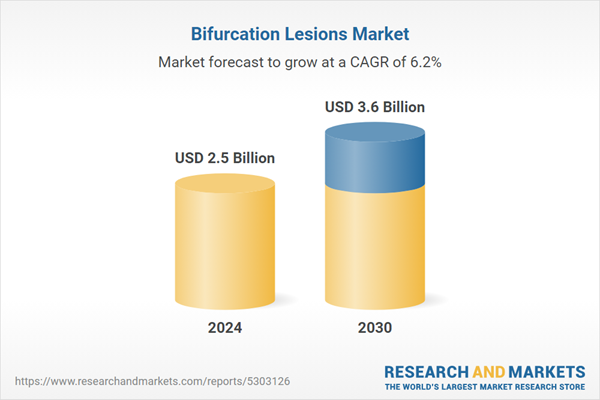The global market for Bifurcation Lesions was valued at US$2.5 Billion in 2024 and is projected to reach US$3.6 Billion by 2030, growing at a CAGR of 6.2% from 2024 to 2030. This comprehensive report provides an in-depth analysis of market trends, drivers, and forecasts, helping you make informed business decisions. The report includes the most recent global tariff developments and how they impact the Bifurcation Lesions market.
Segments: Application (Coronary Vascular, Peripheral Vascular).
Geographic Regions/Countries: World; United States; Canada; Japan; China; Europe (France; Germany; Italy; United Kingdom; Spain; Russia; and Rest of Europe); Asia-Pacific (Australia; India; South Korea; and Rest of Asia-Pacific); Latin America (Argentina; Brazil; Mexico; and Rest of Latin America); Middle East (Iran; Israel; Saudi Arabia; United Arab Emirates; and Rest of Middle East); and Africa.
The analysts continuously track trade developments worldwide, drawing insights from leading global economists and over 200 industry and policy institutions, including think tanks, trade organizations, and national economic advisory bodies. This intelligence is integrated into forecasting models to provide timely, data-driven analysis of emerging risks and opportunities.
Global Bifurcation Lesions Market - Key Trends and Drivers Summarized
What Makes Bifurcation Lesions Complex in Cardiovascular Treatment?
Bifurcation lesions represent a substantial and intricate challenge in interventional cardiology, arising due to blockages located at or near arterial branches where a main artery splits into a secondary pathway. This branching nature of the artery complicates blood flow management, requiring more advanced techniques for effective treatment. Lesions in these locations are particularly difficult to treat because the bifurcation region requires an approach that can support both the main and side branches without compromising blood flow or increasing the risk of complications. The anatomy at these junctions often contains an irregular distribution of plaque, which increases the likelihood of restenosis - a recurrence of blockage - as well as higher rates of adverse cardiovascular events compared to simpler, non-bifurcated lesions. These factors lead to an elevated risk of procedural failure and poor long-term outcomes, which underscores the need for precise and individualized strategies. Additionally, bifurcation lesions present the risk of side branch occlusion during stenting procedures, as traditional stents often fail to adapt to the unique structural requirements of bifurcated areas. Interventional cardiologists, therefore, face a complex decision-making process in identifying the optimal approach for each patient, often having to choose between single-stent or dual-stent techniques based on the specific anatomical and pathological characteristics of the lesion.How Have Innovations in Stenting Techniques Revolutionized Bifurcation Lesion Treatment?
Over recent years, technological advancements have markedly improved stenting techniques, offering more refined and precise solutions for bifurcation lesions that previously posed substantial challenges in terms of both safety and efficacy. Traditional stents, which were largely designed for straight, non-branching arteries, lacked the structural versatility required for the unique demands of bifurcated regions. This limitation has been addressed with the development of specialized bifurcation stents, as well as advanced stenting techniques like the double kissing (DK) crush method and T-stenting with small protrusion (TAP), both of which have shown improved clinical outcomes by reducing the risk of side branch blockage while ensuring durable support for the primary artery. Additionally, bioresorbable vascular scaffolds (BVS) have been introduced as a groundbreaking alternative to traditional stents; these devices gradually dissolve within the artery over time, potentially leaving the vessel in a more natural state and lowering the risk of late-stage complications such as chronic inflammation or restenosis. Furthermore, advancements in imaging technology, including Optical Coherence Tomography (OCT) and Intravascular Ultrasound (IVUS), have greatly enhanced procedural precision. These imaging modalities allow cardiologists to make real-time adjustments during stent deployment, helping to minimize the likelihood of technical errors such as malapposition or incomplete coverage. Together, these innovations underscore a transformative shift in the management of bifurcation lesions, moving towards more effective, safer, and highly individualized treatment options for patients.Why Is the Clinical Management of Bifurcation Lesions Still Challenging?
Despite considerable technological progress, the clinical management of bifurcation lesions continues to be fraught with complexities, largely due to the variable anatomy and dynamics of these lesions and the diverse responses seen across patient populations. One of the most persistent challenges in managing bifurcation lesions lies in determining the appropriate strategy for stenting, as each technique carries its own set of risks and potential benefits. The choice between single-stent and dual-stent approaches, for instance, is not always straightforward and often depends on the specific characteristics of the lesion, such as its location, the degree of plaque buildup, and the patient’s overall health condition. Clinical trials, such as DEFINITION II and BBC ONE, have provided insights into the best practices for treating complex bifurcations, yet they also reveal that outcomes can vary significantly depending on factors like patient demographics, lesion type, and plaque morphology. The procedure itself is typically longer and technically demanding, with increased potential for complications such as stent malapposition, which may lead to incomplete coverage or even stent thrombosis. Additionally, managing these lesions often requires long-term follow-up due to the high risk of restenosis and in-stent thrombosis, both of which can compromise the initial treatment success. Post-procedural care is further complicated by pharmacotherapy protocols such as dual antiplatelet therapy (DAPT), which are necessary to mitigate these risks but can also increase bleeding complications, highlighting the delicate balance clinicians must maintain in the aftercare of bifurcation lesion patients. These ongoing challenges emphasize the need for continuous research, the development of tailored treatment protocols, and innovations that can provide more durable and safer solutions for bifurcation lesions.What Is Driving the Growth of the Bifurcation Lesion Treatment Market?
The growth in the bifurcation lesion treatment market is driven by several key factors, primarily technological advancements, a rising prevalence of cardiovascular diseases, and increasing consumer demand for minimally invasive procedures. The global rise in cases of coronary artery disease, fueled by aging populations and lifestyle-related risk factors such as poor diet, smoking, and sedentary behavior, has generated a growing demand for advanced cardiovascular interventions capable of addressing complex lesions like bifurcations. Technological innovations have played a crucial role in expanding treatment options for these lesions, with dedicated bifurcation stents, enhanced drug-eluting stents, and bioresorbable vascular scaffolds now offering safer and more effective outcomes. The emergence of these devices, alongside precision imaging techniques, has attracted significant investment in research and development from medical device companies, resulting in a robust pipeline of next-generation products tailored to the unique requirements of bifurcation lesions. Additionally, consumer preferences have shifted markedly toward minimally invasive techniques, driven by benefits such as reduced recovery times, lower healthcare costs, and the overall safety profile of interventional procedures compared to traditional surgeries. This shift has fostered greater adoption of interventional techniques for bifurcation lesions, solidifying their place as the preferred approach among both patients and healthcare providers. Rising awareness among healthcare professionals and patients regarding the latest innovations and their clinical advantages has further accelerated this trend. Moreover, supportive regulatory policies and increased government healthcare spending in many countries are facilitating the widespread adoption of these advanced treatment options, helping to make bifurcation lesion intervention a rapidly expanding segment within the cardiovascular market.Report Scope
The report analyzes the Bifurcation Lesions market, presented in terms of units. The analysis covers the key segments and geographic regions outlined below.Segments: Application (Coronary Vascular, Peripheral Vascular).
Geographic Regions/Countries: World; United States; Canada; Japan; China; Europe (France; Germany; Italy; United Kingdom; Spain; Russia; and Rest of Europe); Asia-Pacific (Australia; India; South Korea; and Rest of Asia-Pacific); Latin America (Argentina; Brazil; Mexico; and Rest of Latin America); Middle East (Iran; Israel; Saudi Arabia; United Arab Emirates; and Rest of Middle East); and Africa.
Key Insights:
- Market Growth: Understand the significant growth trajectory of the Coronary Vascular segment, which is expected to reach US$2.0 Billion by 2030 with a CAGR of a 6.1%. The Peripheral Vascular segment is also set to grow at 6.3% CAGR over the analysis period.
- Regional Analysis: Gain insights into the U.S. market, valued at $657.8 Million in 2024, and China, forecasted to grow at an impressive 9.7% CAGR to reach $872.7 Million by 2030. Discover growth trends in other key regions, including Japan, Canada, Germany, and the Asia-Pacific.
Why You Should Buy This Report:
- Detailed Market Analysis: Access a thorough analysis of the Global Bifurcation Lesions Market, covering all major geographic regions and market segments.
- Competitive Insights: Get an overview of the competitive landscape, including the market presence of major players across different geographies.
- Future Trends and Drivers: Understand the key trends and drivers shaping the future of the Global Bifurcation Lesions Market.
- Actionable Insights: Benefit from actionable insights that can help you identify new revenue opportunities and make strategic business decisions.
Key Questions Answered:
- How is the Global Bifurcation Lesions Market expected to evolve by 2030?
- What are the main drivers and restraints affecting the market?
- Which market segments will grow the most over the forecast period?
- How will market shares for different regions and segments change by 2030?
- Who are the leading players in the market, and what are their prospects?
Report Features:
- Comprehensive Market Data: Independent analysis of annual sales and market forecasts in US$ Million from 2024 to 2030.
- In-Depth Regional Analysis: Detailed insights into key markets, including the U.S., China, Japan, Canada, Europe, Asia-Pacific, Latin America, Middle East, and Africa.
- Company Profiles: Coverage of players such as Abbott, Boston Scientific Corporation, C. R. Bard, Inc., Cardinal Health, Johnson& Johnson Services, Inc and more.
- Complimentary Updates: Receive free report updates for one year to keep you informed of the latest market developments.
Some of the 42 companies featured in this Bifurcation Lesions market report include:
- Abbott
- Boston Scientific Corporation
- C. R. Bard, Inc.
- Cardinal Health
- Johnson& Johnson Services, Inc
- Medtronic
- Spectranetics
- Terumo Medical Corporation
Tariff Impact Analysis: Key Insights for 2025
Global tariff negotiations across 180+ countries are reshaping supply chains, costs, and competitiveness. This report reflects the latest developments as of April 2025 and incorporates forward-looking insights into the market outlook.The analysts continuously track trade developments worldwide, drawing insights from leading global economists and over 200 industry and policy institutions, including think tanks, trade organizations, and national economic advisory bodies. This intelligence is integrated into forecasting models to provide timely, data-driven analysis of emerging risks and opportunities.
What’s Included in This Edition:
- Tariff-adjusted market forecasts by region and segment
- Analysis of cost and supply chain implications by sourcing and trade exposure
- Strategic insights into geographic shifts
Buyers receive a free July 2025 update with:
- Finalized tariff impacts and new trade agreement effects
- Updated projections reflecting global sourcing and cost shifts
- Expanded country-specific coverage across the industry
Table of Contents
I. METHODOLOGYII. EXECUTIVE SUMMARY2. FOCUS ON SELECT PLAYERSIII. MARKET ANALYSISIV. COMPETITION
1. MARKET OVERVIEW
3. MARKET TRENDS & DRIVERS
4. GLOBAL MARKET PERSPECTIVE
UNITED STATES
CANADA
JAPAN
CHINA
EUROPE
FRANCE
GERMANY
ITALY
UNITED KINGDOM
SPAIN
RUSSIA
REST OF EUROPE
ASIA-PACIFIC
AUSTRALIA
INDIA
SOUTH KOREA
REST OF ASIA-PACIFIC
LATIN AMERICA
ARGENTINA
BRAZIL
MEXICO
REST OF LATIN AMERICA
MIDDLE EAST
IRAN
ISRAEL
SAUDI ARABIA
UNITED ARAB EMIRATES
REST OF MIDDLE EAST
AFRICA
Companies Mentioned (Partial List)
A selection of companies mentioned in this report includes, but is not limited to:
- Abbott
- Boston Scientific Corporation
- C. R. Bard, Inc.
- Cardinal Health
- Johnson& Johnson Services, Inc
- Medtronic
- Spectranetics
- Terumo Medical Corporation
Table Information
| Report Attribute | Details |
|---|---|
| No. of Pages | 93 |
| Published | April 2025 |
| Forecast Period | 2024 - 2030 |
| Estimated Market Value ( USD | $ 2.5 Billion |
| Forecasted Market Value ( USD | $ 3.6 Billion |
| Compound Annual Growth Rate | 6.2% |
| Regions Covered | Global |









